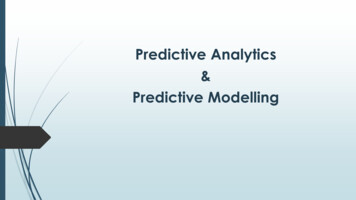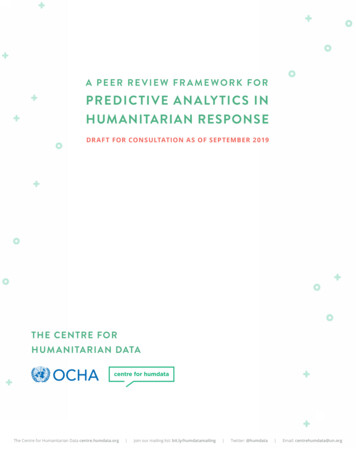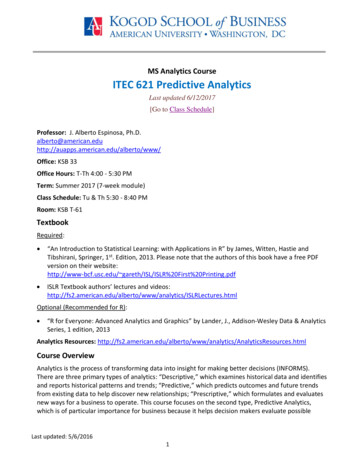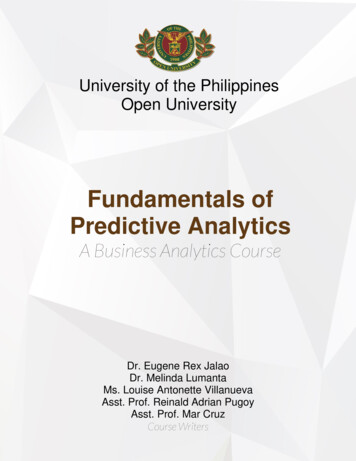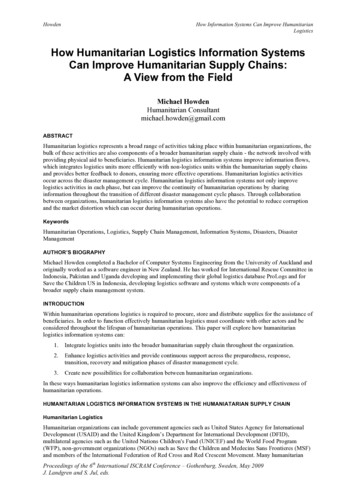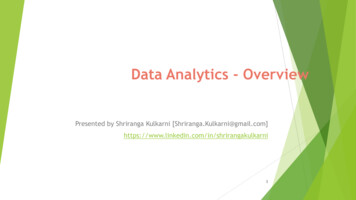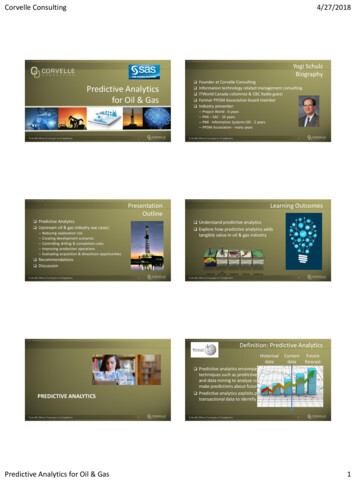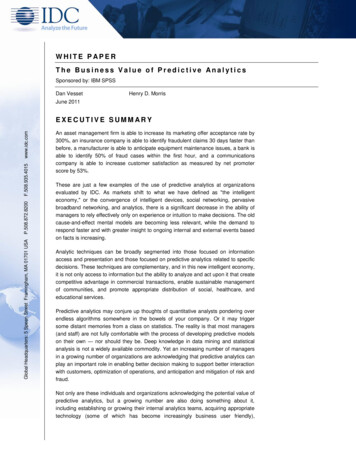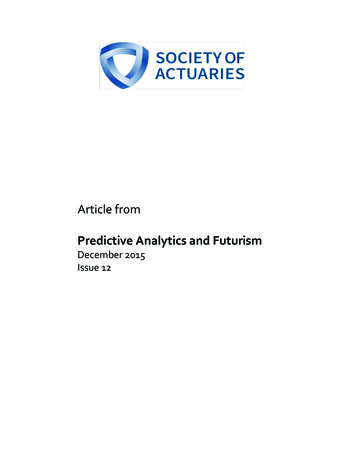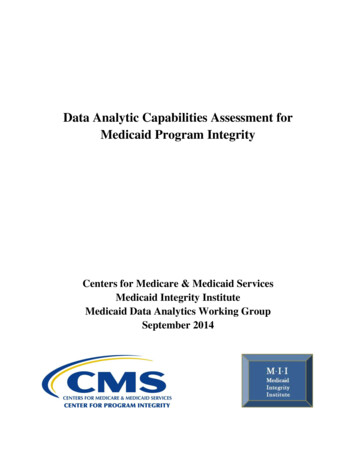
Transcription
Emerging Issues ReportPredictive analytics inhumanitarian action: apreliminary mapping andanalysisKevin HernandezInstitute of Development StudiesTony RobertsInstitute of Development StudiesJune 2020
About this reportThe K4D Emerging Issues report series highlights research and emerging evidence to policy-makers to helpinform policies that are more resilient to the future. K4D staff researchers work with thematic experts and the UKGovernment’s Department for International Development (DFID) to identify where new or emerging research caninform and influence policy.This report is based on 14 days of desk-based research in May 2020.K4D services are provided by a consortium of leading organisations working in international development, led bythe Institute of Development Studies (IDS), with the Education Development Trust, Itad, University of LeedsNuffield Centre for International Health and Development, Liverpool School of Tropical Medicine (LSTM),University of Birmingham International Development Department (IDD) and the University of ManchesterHumanitarian and Conflict Response Institute (HCRI).For any enquiries, please contact helpdesk@k4d.info.AcknowledgementsWe would like to thank Nicholas Leader, who provided advice and guidance on the development of this reportand David Fallows, who served as an external expert reviewer.We would also like to thank Alice Shaw and Lewis Small, who copyedited this report.Suggested citationHernandez, K. and Roberts, T. (2020). Predictive Analytics in Humanitarian Action: a preliminary mapping andanalysis. K4D Emerging Issues Report 33. Brighton, UK: Institute of Development Studies.CopyrightThis report was prepared for the UK Government’s Department for International Development (DFID) and itspartners in support of pro-poor programmes. It is licensed for non-commercial purposes only, except whereotherwise stated. K4D cannot be held responsible for errors or any consequences arising from the use ofinformation contained in this report. Any views and opinions expressed do not necessarily reflect those of DFID,K4D or any other contributing organisation. DFID - Crown copyright 2020.
Contents1.Executive summary . 12.Introduction . 33.Predictive analytics . 34.Predictive analytics in humanitarian aid . 55.Mapping humanitarian predictive analytics . 8Key organisations . 8Organisation type. 9Sectoral application . 11Geographical application . 126.Approaches to predictive analytics . 14Data sources. 14Data collection methods . 16Data analysis methods . 167.What is being predicted? . 17Predicting who . 19Predicting what . 21Predicting where . 22Predicting when . 248.Future Plans . 249.Risks and ethics of predictive analytics . 2510. Conclusion . 29Recommendations . 30References . 31Appendix: List of initiatives included . 38
1. Executive summaryHumanitarian predictive analytics is the use of big data to feed machine learning and statisticalmodels to calculate the probable characteristics of humanitarian emergencies. The technology isbeing used to forecast the likely trajectory and features of humanitarian emergencies includingpandemics, famines, natural disasters and refugee movements. This form of artificial intelligenceis used to predict where and when disasters will unfold, what the defining characteristics of thesituation will be and who will be the most affected populations. Accurate advance predictionenables the pre-positioning of emergency relief finance, supplies and personnel.Forecasting and early warning systems have always been a component of humanitarian action.However, the rapid expansion of computing power and big data has dramatically increased thepotential for predictive analytics in evermore areas of humanitarian action. In the last few years,the term predictive analytics has come to refer primarily to a digital process, drawing on multiplesources of electronic data feeding machine learning algorithms to inform statistical models thatcompute the probability of different humanitarian outcomes. Historic data of previoushumanitarian events plus mobile phone records and social media posts can provide the highvolumes of data needed to analyse food security, predict malnutrition and inform aid deployment.Satellite images, meteorological data and financial transactions can be used to track and predictthe escalation and trajectory of refugee movements.This rapid review research provides the most comprehensive mapping and analysis of predictiveanalytic initiatives in humanitarian aid to date. It documents 49 projects including a variety ofnovel applications (see Appendix for details). It provides a typology of predictive analytics indigital humanitarianism and answers a series of key questions about patterns of current use,ethical risks and future directions in the application of predictive analytics by humanitarian actors.The study took 14 days in May 2020. Forty-nine predictive analytics projects were mapped andanalysed according to the main phases of the humanitarian cycle, type of predictions made,sector of application, geography of application, and technical approach used. Despite thelimitations of rapid response research, some preliminary recommendations are made on thebasis of the findings listed below.Main findings: 1Our research shows that predictive analytics is being used in the mitigation,preparedness and response phases of the humanitarian lifecycle, but not the recoveryphase.Predictive analytics is also used by humanitarian agencies for functions such as humanresource management, fundraising and logistics.Predictive analytics is most often used by projects covered in this review to predict wherehumanitarian crises will occur (71% of initiatives) and who will be affected (40%). Lessoften it is used to predict what the affected situation will look like (26%) and when eventswill occur (18%).By sector, predictive analytics is being applied in a wide variety of humanitarianapplications. The most common are prediction of disease outbreak (9 initiatives),migration (9), conflict (7), disaster risk reduction (6), and food security (4).
Geographically, the initiatives covered in the review were primarily in Africa and the Arabworld, with fewer applications in Asia and Latin America.Technically, most initiatives use historical humanitarian data combined with machinelearning and statistical modelling to produce predictions.The study details examples of a wide range of data sources, data collection techniques,machine learning and analytical models.Predictive analytics is currently being used to complement rather than to replacetraditional humanitarian analysis and forecasting.Humanitarian predictive analytics is being used most often by large internationalagencies and small start-up companies.We found little evidence of affected populations playing a significant role in the design ormanagement of predictive analytics in humanitarian work.Almost half of the initiatives (23) claimed that predictive analytics would improveefficiency by saving time or money although we were unable to validate these claims.The ecosystem of humanitarian predictive analytics is not yet well defined or established.The Centre for Humanitarian Data plays a key global convening role, and sectoral andgeographical specialists are beginning to emerge.The use of predictive analytics by humanitarian actors is still an emerging practicecharacterised by pilot projects and early-stage innovations, which require furtherdevelopment and validation.Open data is a significant enabler of predictive analytics in humanitarian action.Risks and downsides: Feeding machine learning with historic data runs the risk of reproducing past errors,prejudices and inequalities.Feeding machine learning with social media data runs the risk of amplifying the voicesand concerns of the relatively privileged at the expense of the most vulnerable andmarginalised.Automating algorithmic processes is dehumanising and potentially in conflict withhumanitarian commitments to human-centred and participatory processes.The need for computing power and data science expertise makes it difficult for small andlocal actors to lead on predictive analytics – potentially creating new dependencies.Together these risks may unintentionally lead to a form of digital humanitarianism thatreflects, reproduces and amplifies patterns of historic inequality along intersecting linesincluding gender, race and class.Limitations: This preliminary mapping and analysis is based on a rapid 14-day desk review ofsecondary sources, many of which are authored by innovators themselves.It was not always possible to verify the claims made, to clarify whether initiatives are stillon-going, or to find sufficient detail to answer research questions in detail.Additional initiatives and literature continued to come to light even after the cut-off dateshowing scope for additional mapping.Recommendations: 2Governments, humanitarian agencies, funders and private companies should publishmore open data in order to further extend the potential for predictive analytics.
Humanitarian agencies should apply the precautionary principle in data collection, datasafeguarding and responsible data to protect vulnerable populations from harm.To align practice with humanitarian principles and commitments, predictive analyticsactors need to include affected populations in all aspects of the design and project cycle.Funding of predictive analysis should be tied to risk assessment, risk mitigation andknowledge sharing on the ethics and downside-risks of predictive analytics.Funders should support the emerging ecosystem to develop geographical or thematicspecialisms, convene knowledge-sharing events and produce ethical guidelines forpractice.Further research is necessary to build on this preliminary mapping and analysis in thiscrucial and rapidly developing area of humanitarian action.Primary research interviews with humanitarian agencies and key informants would makeit possible to validate claims and establish the current status and future plans of initiativesA small number of case studies would improve depth of understanding about approachesbeing used and proposed pathways to scale.Focus groups or a workshop would surface agency experience of risks and barriers notshared in publicly accessible documents and enable lesson learning.2. IntroductionThe purpose of the report is to provide a preliminary mapping of the breadth of predictiveanalytics initiatives being applied to humanitarian action. This initial scoping study is based on a14-day desk study of secondary sources, many of which were produced by the initiativesthemselves and tended to focus on the positive potential of their ambitions rather than on thelimitations or challenges. Reviewing so many initiatives in such a short period of time meant thatit was not always possible to know whether the initiatives were still on-going or whether theysucceeded in realising their early ambitions. A second round of primary research would be aneffective way to verify and deepen these preliminary findings.This brief introduction is followed by an overview of predictive analytics in wider society ascontext for its application in humanitarian aid in Section 3. Readers familiar with the datacollection techniques, machine learning and statistical modelling technologies that underpinpredictive analytics may wish to skip this section. In Section 4 we summarise the existingliterature on predictive analytics in the humanitarian sector. Section 5 is where we begin topresent findings from our review of current applications of predictive analytics in humanitarianpractice. The review is based on desk-based research reviewing secondary sources: existingacademic literature, grey literature, agency reports and humanitarian websites. In Section 6 weexplain how predictive analytics is being applied in humanitarian practice by presenting newinformation on the range of data sources, data collection methods, and data modellingtechniques being used to predict humanitarian emergencies. Section 7 is where we provide atypology of uses of predictive analytics to calculate where and when humanitarian emergencieswill occur, who will be the most affected populations, and what the situation will look like. InSection 8 we outline future plans and direction for humanitarian predictive analytics. In the finalsections, we review the risks and downsides of predictive analytics in humanitarian practice andmake some tentative conclusions and recommendations.3. Predictive analyticsPredictive analytics involves the recognition of patterns in historic data to calculate the likelihoodof future events. Recommendation engines in Netflix, YouTube and Amazon use predictive3
analytics to recognise patterns in your previous online activity (and that of people with patternssimilar to yours) to statistically calculate the probability of which film, video or book you are mostlikely to want next. Cambridge Analytica and other political marketing consultancies take big datafrom Facebook and the electoral register and use machine learning to build behavioural profilesof every citizen to predict their voting preferences and micro-target them with political influencingmessages. In theory, the more data they have on each individual the more accurate theirpredictive analytics. Siegel (2016: 15) defines predictive analytics as “technology that learns fromexperience [historic data] to predict the future behaviour of individuals in order to drive betterdecisions”. The three main components of predictive analytics are big data, machine learningand statistical modelling.Big data is often crudely defined as data sets that are too big to be analysed in a standardspreadsheet or too big to fit on a personal computer hard drive. Big data can consist of bothstructured and unstructured data. Structured data is data that is quantitative in nature and fitsneatly into the rows and columns of a spreadsheet such as government statistical records orbudgetary information. Unstructured data might include the text of hundreds of differentdocuments, video and photos scraped from social media, Global Positioning System (GPS)mobile phone traces, satellite images and facial recognition images.Machine learning is the most often used tool in predictive analytics. It is a type of artificialintelligence which is used to find patterns in big data and uses them to calculate the probability offuture events. Machine learning takes any explanatory variables that are found to be highlycorrelated with a particular past outcome and uses them to produce predicted future variables. Astatistical model is used to assign a probability ‘score’ to each possibility. This can then be usedto predict anything from voting patterns, commodity prices, migration flows or flood trajectories.Statistical modelling: The statistical analysis can use a single data set and a single model orcombine multiple data and multiple scenarios in ‘ensemble models’. Ensemble modelling is thecombination of multiple statistical models to improve predictability. Predictive analytics often useshundreds or thousands of predictive models to analyse the probability of a range of possiblefuture scenarios (Siegel, 2016). The increased availability of computing power, big data, andmachine learning makes possible the automation of multiple statistical models at a fraction of thetime and cost of traditional data modelling. The predictions generated by statistical modelling canbe provided to human decision-makers to inform their deliberations (as with filmrecommendations that Netflix provides to support your choice of viewing) or the prediction can beused to drive an automated algorithmic decision-making process (as when YouTube auto-playsits video choice for you). Automated analytics is an emerging field where decisions based onpredictive analytics are algorithmically determined and implemented entirely automatically(Davenport, 2015; Castellucia & Le Métayer, 2019).Predictive analytics has limits, comes with risks and raises ethical issues. Predicting thatsomething will happen to a specific individual, community, or geography with 100% accuracy isimpossible. It is not clear where legal liability resides if predictive analytics leads to injury ordeath. Predictive analytics is used in ways that are ethically unsound, for example, to nudgeindividuals towards thoughts, behaviours and voting preferences without their consent ortransparency (as per Cambridge Analytica). There is also a growing research literaturedocumenting evidence that the use of historic data in machine learning and algorithmic decisionmaking often reflects, reproduces and amplifies historical patterns of gender, race and class(dis)advantage and inequality (Benjamin, 2019; Criado Perez, 2019; Eubanks, 2018; Hernandez& Roberts, 2018; Noble, 2018; O’Neil, 2017). The response of technologists to this (conscious orunconscious) bias in data and the politics in algorithms is often to try to manufacture a4
technological fix of the data or the algorithm rather than to address the social problem itself or itsroot causes. It has also been argued that the use of algorithms, artificial intelligence andautomated decision-making is dehumanising by definition in that it replaces the scope of humanagency, deliberation and dialogue (Roberts & Faith, in press). Bastani and Kim (2018) are amongthe many scholars who have argued that it is important to keep domain experts engaged in aniterative human process of predictive analysis (the so-called ‘humans-in-the-loop’ argument).4. Predictive analytics in humanitarian aidHumanitarian actors and the humanitarian sector are often criticised for being slow to act andoperationally inefficient (Swaminathan, 2018). In response to these challenges, the humanitariansector has sought to shift from being responsive to disasters and crises to being moreanticipatory. This has involved the increased use of early warning and forecasting systems tostrengthen disaster prevention, preparedness and mitigation. Predictive analytics holds thepotential to extend these proactive capabilities before and during disasters (Akter & Wamba2019; Swaminathan, 2018).The disaster management lifecycle consists of four stages: mitigation, preparedness, response,and recovery (Haigh, n.d.). The mitigation stage is designed to decrease the chances of adisaster happening or its potential impact on vulnerable populations and places.Figure 1. The four phases of the disaster management cycleThe DisasterManagement CycleSource: Adapted from Haigh, n.d.1Adapted from “Disaster Management Lifecycle”, by R. Haigh, U/2017 spring/GEOL 308/lectures/lecture 01/GEOL 308 suppl reading 02 Introduction to Disaster Management Lifecycle.pdf University of Salford. Reproduced under licence CC BY-NC-SA 2.5.15
The preparedness phase aims to improve readiness for future disasters and includes fundsallocation and prepositioning of assets. The response phase occurs after the disaster has hit andhumanitarian actors are active on the ground. The recovery phase includes actions seeking tobring about long-term stabilisation after the disaster (Akter & Wamba, 2019). In a systematicreview of 76 scholarly articles on big data in disaster management, Akter and Wamba (2019)found that 37% of all articles focused on mitigation, 29% on response, 23% on preparedness andonly 3% focused on recovery.The existing literature highlights the potential for big data to help predict and prevent disastersbut that there is a lack of real-world case studies because the use of big data in the humanitariansector is relatively new. Watson et al. (2017: 17–18) found that although “studies demonstratethat crisis data have the potential to positively impact preparedness, there has been littleempirical research relating to the actual use of crisis data for preparedness activities”. Aworkshop hosted by the Centre for Humanitarian Data in April 2019 also found that “Most of themodels that were shared by organizations are in a pilot phase and still need further validationand feedback before they can be used to create a trusted signal for the [humanitarian] sector torespond to” and suggested that predictive analytics models will need to be used alongsideexisting forecasting techniques until the evidence base is built (Centre for Humanitarian Data,2019a: 2). The workshop also highlighted the need for case studies and documentation ofhumanitarian predictive analytic projects.There are signs that this is changing. In January (of 2020), the International Federation of RedCross and Red Crescent Societies (IFRC) made its first use of its ‘Early Action FundingMechanism’ tool to provide cash to vulnerable farmers predicted to loose livestock in aparticularly harsh winter (IFRC, 2020). Although still largely in their pilot phases, several otherhumanitarian predictive analytics projects have been included in grey literature and/or mediacoverage, including the World Bank’s Famine Action Mechanism, which aims to predict faminesbefore they happen and trigger funding based on predictions to facilitate earlier responses andpossibly prevent crises (OCHA, 2019a); Save the Children’s forced displacement prediction toolwhich aims to provide actionable predictions about how a situation of forced displacement islikely to evolve over time (Morgan & Kaplan, 2018); and the UNHCR’s Jeston project which canpredict the displacement of people in Somalia at least a month in advance (UNHCR, 2019).Although the use of predictive analytics is now widespread in the private and public sector inmany developed countries, in the development and humanitarian aid sector the use of big data,machine learning and artificial intelligence are still at an exploratory stage (Paul, Jolley &Anthony, 2018). Although the use of predictive analytics by humanitarian actors is still in itsinfancy, attempts by humanitarian actors to apply predictive analytics are not completely new.One early proof of concept dates back to 2010 during the aftermath of the Haiti Earthquake,where call records of 1.9 million Haitians were analysed between 1.5 months prior to and almostone year following the earthquake. Results showed that the movement of Haitians within thecountry could be predicted during the first three months of the disaster (Lu, Bengtsson & Holme,2012).Moreover, predictive analytics are not the humanitarian sector’s first attempt at predictingdisasters. The sector has long made use of forecasting early warning methodologies. However,as is the case in other sectors, the promise of predictive analytics in its new digital form (e.g. thecombination of big data, machine learning and statistical modelling) is to go much further and getthere faster than traditional forecasting and early warning methodologies. The following excerptfrom a U.S. Agency for International Development (USAID) commissioned report on machinelearning captures this well:6
Of course, not all early-warning systems rely on machine learning. It is common for peopleto analyse geospatial, economic, or health data and make predictions about what mighthappen. One major difference is that human analysts tend to make predictions based on asmall number of strong signals, such as anticipating a famine if rainfall is low and foodprices are high. In contrast, machine learning methods excel at combining a large numberof weak signals, each of which might have escaped human notice. This gives machinelearning-based early warning systems the potential to find the ‘needle in a haystack’ andspot emerging problems more quickly than traditional methods (Paul et al., 2018: 19).The literature reviewed found a series of claims for the relevance of predictive analytics inrelation to the different phases of the humanitarian lifecycle: in disaster mitigation, preparedness,response and recovery. These claims are summarised below.Mitigation: Predictive analytics can inform mitigation phase strategies that seek to preventdisasters and/or crises from happening or limit their impact once they happen (Akter & Wamba,2019). Predictive analytics can be used to calculate vulnerability to natural hazards and pinpointwhich households, communities, and infrastructure humanitarian actors should prioritise(Letouze, Sangokoya & Ricard, 2017). The idea of using vulnerability as a predictor is not new.“vulnerability has a predictive aspect: it should be possible—on the basis of the characteristics ofa group of people who are exposed to a particular hazard—to identify their capacity forresilience” (Cannon, 2008: 10). Locating vulnerable people and geographies vulnerable tonatural hazards can be crucial as it is vulnerability to hazards that lead to disasters rather thanthe hazards themselves (Cannon, 2008). Addressing these vulnerabilities, therefore, has thepotential to prevent or limit disasters.Preparedness: In the planning phase, predictive analytics can provide actionable early warningto authorities, citizens and humanitarian actors about imminent threats (Akter & Wamba, 2019).What is considered early will vary for different disasters and crises. For example, it may bepossible to predict a famine months ahead of time, but it may only be possible to predict whichareas are under threat of flooding due to a hurricane a week in advance or an earthquake justminutes before it happens (Watson et al., 2017). Hala Systems, one of the initiatives uncoveredduring our mapping exercise predicts which areas of Syria will be bombed by military planes 5 to10 minutes before the bombs land, sending text and instant messages to those in the affectedlocations (Hala Systems Inc., 2019). This very narrow time window provides citizens with justenough time to take shelter.Response: During the response phase, predictive analytics can help provide situationalawareness. The use of predictive analytics at the response stage is strongly related to ‘nowcasting’ which refers to making real-time inferences about what will happen in the short termbased on data (Letouze et al., 2017).“In the short term, the information gained from social mediaand other aerial imagery has the potential to inform those managing a crisis, who and wherevulnerabilities might lie as a crisis develops. This could include ‘trend analysis’ and ‘predictingwhich populations are vulnerable’ to health [and other] risks, abuse or other additional effects”(Watson et al., 2017: 19–20). Predictive models based on call records and GPS data has beenused to predict where people are most likely to flee or relocate (Lu et al., 2012). Predictiveanalytics can also provide early assessments of damages and losses (e.g. by analysing andclassifying satellite imagery of the roofs of people’s homes) providing humanitarian actors withmuch needed data to guide rapid response (Letouze et al., 2017).Recovery: Relatively little work has been done to develop thinking on how predictive analyticscould be used during recovery efforts. Echoing findings from Akter and Wamba (2019) our7
literature review found that research on predictive analytics in the humanitarian sector lacksstudies on the use of predictive analytics in the recovery phase of humanitarian action. In ourmapping of the 49 cases of humanitarian predictive analytic initiatives, we found even coveragein the mitigation, pre
Predictive analytics is also used by humanitarian agencies for functions such as human resource management, fundraising and logistics. Predictive analytics is most often used by projects covered in this review to predict where humanitarian crises will occur (71% of initiatives) and who will be affected (40%). Less
